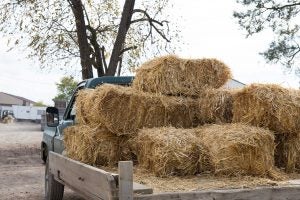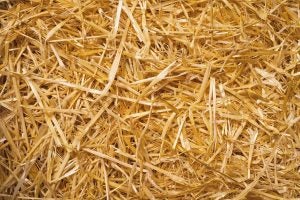Straw and hay are a huge part of everyday life for many farmers, but because the two things look so similar, it’s certainly possible that non-farmer wouldn’t know the difference. What is the difference between hay and straw? And can the terms “hay” and “straw” be used interchangeably?
While some people do use the terms somewhat interchangeably, they really shouldn’t (and your local farm store clerk will hopefully clarify if you say “straw” that you really mean straw). There is definitely a difference between the hay and straw: Hay is grown primarily for livestock feed, while straw is used for livestock bedding and has very little feed value.

What to know about hay
Hay can be a legume like the very popular alfalfa hay; or grassy hay like Bermuda, orchardgrass, Timothy or maybe even clover, just to name a few. Different types of hay offer varying nutritional profiles, and the region where the crops are grown plays a role in animal diet as well. It’s very important that hay is dry when cut, raked, and baled, as the crop can become damaged or moldy if rained on. Hay that’s damp when baled can also become a fire hazard, because mold-causing bacteria generate a lot of heat.
Good, dry storage is important — and hay can be made into square or round bales. The greener that hay is, the less that it has likely deteriorated in quality.
Small square bales are usually more physically labor intensive as they’re heavy, but not intrusively so — so they can be carried by hand if you’re feeding a smaller number of animals in separate pens. Round bales — which are often either 4, 5, or 6 feet in diameter — last a lot longer for bigger herds of animals (especially if you have a feeder so the livestock don’t trample the hay into the ground). These kinds of bales weigh about 1,200 pounds on average and should be moved with heavy equipment — though if you rolled it off the back of your pickup by hand, you wouldn’t be the first person to do that, just know it can be really dangerous! Expect to pay $35 to $60 for a round bale during a normal year (meaning: not a drought year), but, of course, that dollar amount can vary wildly based on geography, quantity, and bale sizing. Also note that “horse-quality” hay is going to be more expensive than hay bales for cattle.
Hay — which is typically cut three times a year (but as many as five) — is an especially important crop for animals that don’t have much access to pasture or need the supplemental feed in the cold winter months. According to Hay and Forage Grower, for example, you would need a little over seven 5-by-5-foot round bales to feed 30 cows for a week under such conditions.

What to know about straw
Straw is a byproduct of cereal grain farming: Wheat, rice, oat, barley, rye, buckwheat, and more can all offer great straw product. About 50 percent of the plant yield makes up straw.
Straw bales are generally much lighter in weight and color than hay bales and have a noticeably different texture. Oftentimes, when you go on a classic “hay ride,” there’s a good chance it’s actually straw, not hay, that you’re seated on in the flat bed!
Hay can be much heavier and itchier and is a food-based product instead of a comfortable bedding-type (or ornamental/decorative) product. Straw is used all around the world in producing many other products such as hats, thatched roofs, baskets, and cheap cardboard (strawboard), among others. It’s also a big hit in the gardening world, as it can be used to make straw bale gardens or used as mulch, compost, or other weed control.
Straw bales are sold in a variety of sizes, like hay, but you’re probably mostly commonly going to find it in the small square bale format (yes, it’s technically a right rectangular prism, but just go with us here on the farm term “square bale”). It’s not uncommon to pay $4 to $5 per bale, with prices fluctuating based on season and demand.
Another big difference between hay and straw is that hay is typically harvested before the plants make seed and are just growing leaves. These leaves are more nutrient packed and easy for an animal to digest compared to the low-quality stems left behind as straw. Straw is a great way to “recycle” the leftover parts of the plant while hay is grown specifically for feed.
There you have it, a crash course on the differences between hay and straw. The next time someone quizzes you about straw, you can say, “Hay, I know the difference!”
Michelle Miller, the Farm Babe, is a farmer, public speaker and writer who has worked for years with row crops, beef cattle, and sheep. She believes education is key in bridging the gap between farmers and consumers.



